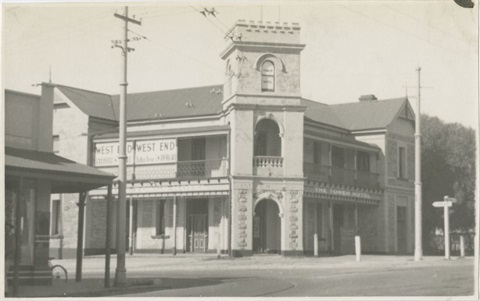Pubs of Burnside - World's End and Tower Hotel
Published on 21 January 2020

A History of Pubs in Burnside Part 3 - Tower Hotel and World's End Hotel
At the far east corner of the City of Burnside, part of the former village of Mak-gill (now Magill), were two hotels, Tower Hotel and World's End. The Tower Hotel still stands at the major intersection of Magill and St Bernards Road. World's End Hotel was located on the corner of Pepper Street and Magill Road.
The Tower Hotel, originally the Woodforde Arms Hotel, was first built in 1840 on the corner of Mak-gill and St Bernards Road. It later became the East Torrens Hotel. When Tom O'Hara remodelled the building and added a tower in 1910 the name was changed to the Tower Hotel. The 1910 addition echoes the high tower of Murray House on Fourth Creek, north from the hotel, which was the second house built by Alexandra Borthwick Murray in 1881.

Tower Hotel, circa 1938. PRG 287/1/5/79. Courtesy of State Library of South Australia.
The World's End Hotel was built in 1845 further down from the major intersection and '...was a famous staging post for heavy traffic halting overnight at Magill with stables that were the most extensive of any in the colony at the time' (Roxley 1976). The Hotel may well have been named by the Scottish, for it had the same name as a pub on the Royal Mile (High Street) in Edinburgh. Perhaps tongue in cheek, seeing that Magill was really at the 'edge of this capital's world', surrounded by bush wattle and mighty eucalyptus interspersed with welcome hotels. The life of the World's End Hotel diminished when the tee-totallers worked to revoke its licence and it became a coffee house around 1909. It was demolished on account of salt damp in the 1960s.
The lane entrance to the Hotel's stables became Pepper Street, and until electricity arrived around 1908, lighting was primitive, with Hurricane Lamps swinging outside the hotels. The image of the World's End in 1884, shows the hitching post and wooden water trough outside the double storied bluestone building. Although, it is documented that a Post Office replaced the hotel, the present old double-storied building next door to the Post Office looks very much like the hotel, so controversy reigns. No 550 Magill Road next door to World’s End Hotel was A C Martin's undertaker and carpentry business built in 1903 and operated by Martin's son, aged 90, till 1976. The architecture is very similar to the World’s End Hotel.

World's End Hotel, circa 1884. B 9717. Courtesy of State Library of South Australia.

Site next door to World's End Hotel, 2018.
The Hotels were in the centre of Mak-gill village, which was laid out in true Scottish style with allotments for a chapel, burial ground, sites for a grain merchant and other suppliers. It was the first of the foothill villages of Adelaide to be sub-divided and the first outside of Adelaide to have a village school. Village life revolved around the Hotels and the Institute building, which opened as a Library and Reading Room in 1857.
The Hotels' customers reflected the mixed urban and country population and included timber cutters from the 'Tiers' in the Adelaide foothills, village families and workers from the nearby Auldana and Penfolds Wineries. When land was deeded to the 'Mak-gill School Trust so they could build a schoolroom on it' (P. Dadds, 1986) a high proportion of notable Scots and families were named including David Cowan (pioneer), Alexander Calderwood (Wheelwright), Peter Little (Blacksmith), John and James Inglis (farmers), the Auld family, the Penfolds family and David Wylie (Master of Arts who started a private school nearby). All the listed names were Scottish, but we do not know who drank a dram of whisky at the hotels or who were steadfast tee-totallers.
Written by Diana Chessell, Historian to the Pubs Series. BA Adelaide
References:
Chessell, Diana. 'Murray House and its scholastic traditions', Hyde Park Press, 2012.
Dadds, P. 'Under the shadowy hills: a history of Magill school', Peacock Publications, 1986.
Greenwood, Roxley. 'Magill Sketchbook', Rigby Limited, 1976).
Warburton, Elizabeth. 'From the river to the hills: Campbelltown 150 Years', Corporation of the City of Campbelltown, 1986.
Warburton, Elizabeth. 'The Paddocks Beneath: A history of Burnside from the Beginning', Corporation of the City of Burnside, 1981.